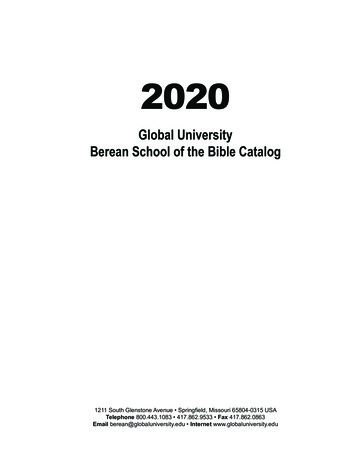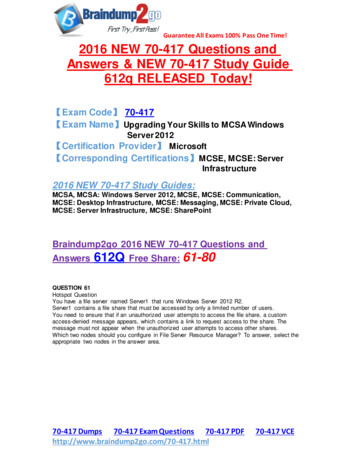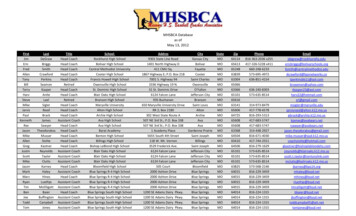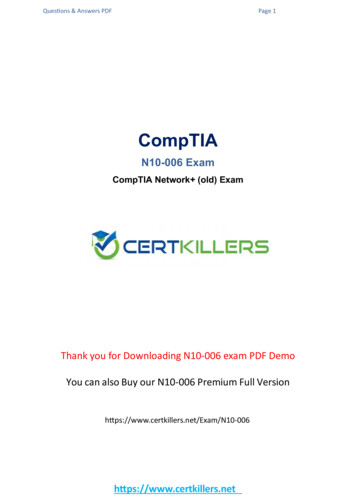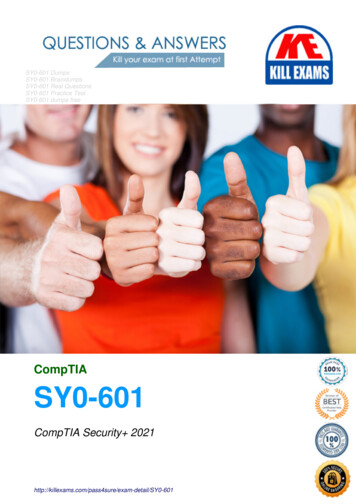
Transcription
70-417 Dumps70-417 Braindumps70-417 Real Questions70-417 Practice Test70-417 dumps freeMicrosoft70-417Upgrading Your Skills to MCSA Windows Server 417
Question: 683You have a server named Data1 that runs a Server Core Installation of Windows Server 2012 R2 Standard.You need to configure Data1 to run a Server Core Installation of Windows Server 2012 R2 Datacenter. You want to achieve this goal by using the minimumamount of administrative effort.What should you perform?A. An online servicing by using DismB. An offline servicing by using DismC. An upgrade installation of Windows Server 2012 R2D. A clean installation of Windows Server 2012 R2Answer: AExplanation:A. Not least effortB. Not least effortC. dism /online /set-editionD. offline would be less ideal and more work ex: DISM /online /Set-Edition:ServerEnterprise rver 2008 R2/2012 contains a command-line utility called DISM (Deployment Image Servicing and Management tool). This tool has many features, but oneof those features is the ability to upgrade the edition of Windows in use. Note that this process is for upgrades only and is irreversible. You cannot set aWindows image to a lower edition. The lowest edition will not appear when you run the /Get-Target Editions option. If the server is running an evaluationversion of Windows Server 2012 R2 Standard or Windows Server 2012 R2 Datacenter, you can convert it to a retail version as follows:If the server is a domain controller, you cannot convert it to a retail version. In this case, install an additional domain controller on a server that runs a retailversion and remove AD DS from the domain controller that runs on the evaluation version. From an elevated command prompt, determine the current editionname with the command DISM /online /Get-CurrentEdition. Make note of the edition ID, an abbreviated form of the edition name. Then run DISM /online/Set-Edition: edition ID , providing the edition ID and a retail product key.The server will restart twice.There are a couple of ways to install the GUI from the command prompt, although both use the same tool -DISM (Deployment Image Service Manager).When you are doing it for a single (local) server, the command is:Dism /online /enable-feature /featurename:ServerCore-FullServer /featurename: and-2012/jj574204(v rsions/windows/it-pro/windows-7/dd744380(v ws.10)http://blogs.technet.com/b/server 08-r2-without-media.aspxQuestion: 684Your network contains an Active Directory forest named contoso.com.The forest contains two domains named contoso.com and child.contoso.com and two sites named Site1 and Site2. The domains and the sites are configured asshown in following table.When the link between Site1 and Site2 fails, users fail to log on to Site2.You need to identify what prevents the users in Site2 from logging on to the child.contoso.com domain.What should you identify?A. The placement of the infrastructure masterB. The placement of the global catalog serverC. The placement of the domain naming masterD. The placement of the PDC emulatorAnswer: BExplanation:User logon. In a forest that has more than one domain, two conditions require the global catalog during user authentication:In a domain that operates at the Windows 2000 native domain functional level or higher, domain controllers must request universal group membershipenumeration from a global catalog server. When a user principal name (UPN) is used at logon and the forest has more than one domain, a global catalogserver is required to resolve the /library/cc728188(v ws.10).aspx
Question: 685You have a server named Server1 that runs Windows Server 2012 R2.You plan to create an image of Server1.You need to remove the source files for all server roles that are not installed on Server1.Which tool should you use?A. dism.exeB. servermanagercmd.exeC. ocsetup.exeD. imagex.exeAnswer: AExplanation:The Dism utility can be used to create and mount an image of Server1.Incorrect Answers:B: The ServerManagerCmd.exe command-line tool has been deprecated in Windows Server 2008 R2.C: The Ocsetup.exe tool isused as a wrapper for Package Manager (Pkgmgr.exe) and for Windows Installer (Msiexec.exe). Ocsetup.exe is a command-lineutility that can be used to perform scripted installs and scripted uninstalls of Windows optional components. The Ocsetup.exe tool replaces the Sysocmgr.exetool that Windows XP and Windows Server 2003 use.D: ImageX is a command-line tool in Windows Vista that you can use to create and manage Windows image (.wim) files. A .wim file contains one or morevolume images, disk volumes that contain images of an installed Windows operating /joscon/archive/2010/08/26/adding-features-with- en-us/library/cc749447(v ary/dd744382(v ws.10).aspQuestion: 686Your network contains a server named Server1 that runs Windows Server 2012. Server1 has the Hyper-V server role installed.Server1 hosts four virtual machines named VM1, VM2, VM3, and VM4.Server1 is configured as shown in the following table.You plan to schedule a complete backup of Server1 by using Windows Server Backup.You need to ensure that the state of VM1 is saved before the backup starts.What should you configure?A. NUMA topologyB. Resource controlC. Resource meteringD. Virtual Machine ChimneyE. The VLAN IDF. Processor CompatibilityG. The startup orderH. Automatic Start ActionI. Integration ServicesJ. Port mirroringK. Single-root I/O virtualizationAnswer: IExplanation:Backup Operations in Hyper-VNo VSS Writer Available?In some cases, you need an Application-consistent backup but there is no VSS writer available. One example of this is MySQL. Hyper-V backups of virtualmachines containing MySQL will always result in either a crash consistent or an image-level backup. For MySQL, the latter is probably acceptable as MySQLdoesn’t perpetually expand the log file. However, if you’re using MySQL within a VSS-aware VM, then a Hyper-Vbased backup tool is going to take acrashconsistent backup. MySQL (like any other database system) isn’t always recoverable from a crash-consistent backup; tool is going to take a crashconsistent backup. MySQL (like any other database system) isn’t always recoverable from a crash-consistent backup; even when recovery is possible, it may be
painful.MySQL is just one example; any number of line-of-business Applications could tell a similar tale. In the case of MySQL, one solution is to find a guest-levelbackup Application that is MySQL- aware and can back it up properly. For Applications for which no backup Application has a plug-in, you may need to havepreand post-backup scripts that stop services or close Applications. If brief downtime is acceptable, you can disable the Backup item in Hyper-V IntegrationServices, thereby forcing Hyper-V to save the state of the VM during backup. This technique results in an image-level backup and can be used on anyApplication that doesn’t have a VSS writer.References: 2/Question: 687Your network contains a server named Server1 that runs Windows Server 2012 R2. Server1 has the Hyper-V server role installed.Server1 hosts four virtual machines named VM1, VM2, VM3, and VM4.Server1 is configured as shown in the following table.VM3 is used to test applications.You need to prevent VM3 from synchronizing its clock to Server1.What should you configure?A. NUMA topologyB. Resource controlC. Resource meteringD. Virtual Machine ChimneyE. The VLAN IDF. Processor CompatibilityG. The startup orderH. Automatic Start ActionI. Integration Services
J. Port mirroringK. Single-root I/O virtualizationAnswer: IExplanation:Integration Services settings on virtual machines includes services such as operating system shutdown, time synchronization, data exchange, Heart beat, andBackup (volume snapshot services. Thus you should disable the time synchronization using Integration virtual-machines.aspxExam Ref 70-410, Installing and Configuring Windows Server 2012, Chapter 3: Configure Hyper-V, Objective 3.1: Create and Configure virtual machinesettings, p. 144Question: 688Your network contains a server named Server1 that runs Windows Server 2012. Server1 has the Hyper-V server role installed.Server1 hosts four virtual machines named VM1, VM2, VM3, and VM4.Server1 is configured as shown in the following table.VM2 sends and receives large amounts of data over the network.You need to ensure that the network traffic of VM2 bypasses the virtual switches of the parent partition.What should you configure?A. NUMA topologyB. Resource controlC. Resource meteringD. Virtual Machine ChimneyE. The VLAN IDF. Processor CompatibilityG. The startup order
H. Automatic Start ActionI. Integration ServicesJ. Port mirroringK. Single-root I/O virtualizationAnswer: KExplanation:Single-root I/O virtualization -capable network adapters can be assigned directly to a virtual machine to maximize network throughput while minimizingnetwork latency and the CPU overhead required for processing network -us/library/cc766320(v ary/hh831410.aspxExam Ref 70-410, Installing and Configuring Windows Server 2012, Chapter 3: Configure Hyper-V, Objective 3.1: Create and Configure virtual machinesettings, p. 144Training Guide: Installing and Configuring Windows Server 2012: Chapter 7: Hyper-V Virtualization, Lesson 2: Deploying and configuring virtual machines,p. 335Question: 689You perform a Server Core Installation of Windows Server 2012 R2 on a server named Server1.You need to add a graphical user interface (GUI) to Server1.Which tool should you use?A. The imagex.exe commandB. The ocsetup.exe commandC. The setup.exe commandD. The dism.exe commandE. The Install-Module cmdletAnswer: DExplanation:The DISM command is called by the Add-WindowsFeature command. Here is the systax for DISM:Dism /online /enable-feature /featurename:ServerCore-FullServer /featurename:Server- Gui-Shell /featurename:Server-Gui-MgmtQuestion: 690Your network contains a server named Server1 that runs Windows Server 2012. Server1 has the Hyper-V server role installed.Server1 hosts four virtual machines named VM1, VM2, VM3, and VM4.Server1 is configured as shown in the following table.
You install a network monitoring application on VM2.You need to ensure that all of the traffic sent to VM3 can be captured on VM2.What should you configure?A. NUMA topologyB. Resource controlC. Resource meteringD. Virtual Machine ChimneyE. The VLAN IDF. Processor CompatibilityG. The startup orderH. Automatic Start ActionI. Integration ServicesJ. Port mirroringK. Single-root I/O virtualizationAnswer: JExplanation:What’s New in Hyper-V Virtual SwitchPort MirroringWith Port Mirroring, traffic sent to or from a Hyper-V Virtual Switch port is copied and sent to a mirror port.There are a range of applications for port mirroring an entire ecosystem of network visibility companies exist that have products designed to consume portmirror data for performance management, security analysis, and network diagnostics. With Hyper-V Virtual Switch port mirroring, you can select the switchports that are monitored as well as the switch port that receives copies of all the traffic.The following examples configure port mirroring so that all traffic that is sent and received by both MyVM and MyVM2 is also sent to the VM namedMonitorVM.Set-VMNetworkAdapter VMName MyVM PortMirroring SourceSet-VMNetworkAdapter VMName MyVM2 PortMirroring SourceSet-VMNetworkAdapter VMName MonitorVM PortMirroring DestinationReferences: 8.aspx#bkmk portmirrorQuestion: 691Your network contains an Active Directory domain named contoso.com. The domain contains a server named Server1. Server1 runs Windows Server 2012 R2and has the Hyper-V server role installed.On Server1, you create and start a virtual machine named VM1. VM1 is configured as shown in the following table.You plan to create a checkpoint of VM1.You need to recommend a solution to minimize the amount of disk space used for the checkpoint of VM1.What should you do before you create the checkpoint?A. Decrease the Maximum RAM.B. Convert Disk1.vhd to a dynamically expanding disk.C. Run the Stop-VM cmdlet.D. Run the Resize-VHD cmdlet.E. Configure VM1 to have a smaller virtual disk.Answer: CExplanation:For checkpoints created when the virtual machine is stoppedThe checkpoint contains the state of the hard disks only.For checkpoints created when the virtual machine is running
The checkpoint contains the state of the hard disks and the data in memory.Note: A checkpoint saves the state of each virtual hard disk that is attached to a virtual machine and all of the hard disk’s contents, including application datafiles. For virtual machines on Hyper-V and VMware ESX Server hosts, a checkpoint also saves the hardware configuration information. By creatingcheckpoints for a virtual machine, you can restore the virtual machine to a previous state.
For More exams visit https://killexams.com/vendors-exam-listKill your exam at First Attempt.Guaranteed!
Exam Ref 70-410, Installing and Configuring Windows Server 2012, Chapter 3: Configure Hyper-V, Objective 3.1: Create and Configure virtual machine settings, p. 144 Training Guide: Installing and Configuring Windows Server 2012: Chapter 7: Hyper-V Virtualization, Lesson 2: Deployi

